Novel Push-Pull Benzodithiophene-Containing Polymers as Hole-Transport Materials for Efficient Perovskite Solar Cells
Abstract
1. Introduction
2. Results and Discussion
3. Materials and Methods
4. Conclusions
Supplementary Materials
Author Contributions
Funding
Institutional Review Board Statement
Informed Consent Statement
Data Availability Statement
Acknowledgments
Conflicts of Interest
References
- Min, H.; Lee, D.Y.; Kim, J.; Kim, G.; Lee, K.S.; Kim, J.; Paik, M.J.; Kim, Y.K.; Kim, K.S.; Kim, M.G.; et al. Perovskite Solar Cells with Atomically Coherent Interlayers on SnO2 Electrodes. Nature 2021, 598, 444–450. [Google Scholar] [CrossRef] [PubMed]
- NREL. Best Research Efficiencies. Available online: https://www.nrel.gov/Pv/Cell-Efficiency.html (accessed on 20 November 2022).
- Liu, X.; Han, Q.; Liu, Y.; Xie, C.; Yang, C.; Niu, D.; Li, Y.; Wang, H.; Xia, L.; Yuan, Y.; et al. Light-Induced Degradation and Self-Healing inside CH3NH3PbI3-Based Solar Cells. Appl. Phys. Lett. 2020, 116, 253303. [Google Scholar] [CrossRef]
- Tepliakova, M.M.; Mikheeva, A.N.; Somov, P.A.; Statnik, E.S.; Korsunsky, A.M.; Stevenson, K.J. Combination of Metal Oxide and Polytriarylamine: A Design Principle to Improve the Stability of Perovskite Solar Cells. Energies 2021, 14, 5115. [Google Scholar] [CrossRef]
- Liu, X.; Ding, X.; Ren, Y.; Yang, Y.; Ding, Y.; Liu, X.; Alsaedi, A.; Hayat, T.; Yao, J.; Dai, S. A Star-Shaped Carbazole-Based Hole-Transporting Material with Triphenylamine Side Arms for Perovskite Solar Cells. J. Mater. Chem. C 2018, 6, 12912–12918. [Google Scholar] [CrossRef]
- Bakr, Z.H.; Wali, Q.; Fakharuddin, A.; Schmidt-Mende, L.; Brown, T.M.; Jose, R. Advances in Hole Transport Materials Engineering for Stable and Efficient Perovskite Solar Cells. Nano Energy 2017, 34, 271–305. [Google Scholar] [CrossRef]
- Wang, Y.; Duan, L.; Zhang, M.; Hameiri, Z.; Liu, X.; Bai, Y.; Hao, X. PTAA as Efficient Hole Transport Materials in Perovskite Solar Cells: A Review. Solar RRL 2022, 6, 2200234. [Google Scholar] [CrossRef]
- Luo, J.; Lin, F.; Xia, J.; Yang, H.; Zhang, R.; Malik, H.A.; Shu, H.; Wan, Z.; Han, K.; Wang, R.; et al. An Efficient and Hydrophobic Molecular Doping in Perovskite Solar Cells. Nano Energy 2021, 82, 105751. [Google Scholar] [CrossRef]
- Cheng, F.; Cao, F.; Ru Fan, F.; Wu, B. Promotion Strategies of Hole Transport Materials by Electronic and Steric Controls for n–i–p Perovskite Solar Cells. ChemSusChem 2022, 15, e202200340. [Google Scholar] [CrossRef] [PubMed]
- Wang, H.; Wu, C.; Zhai, M.; Chen, C.; Tao, L.; Ding, X.; Miao, Y.; Cheng, M. Constructing Efficient Hole Transport Material through π-Conjunction Extension for Perovskite Solar Cell. ACS Appl. Energy Mater. 2022. [Google Scholar] [CrossRef]
- Ye, L.; Zhang, S.; Huo, L.; Zhang, M.; Hou, J. Molecular Design toward Highly Efficient Photovoltaic Polymers Based on Two-Dimensional Conjugated Benzodithiophene. Acc. Chem. Res. 2014, 47, 1595–1603. [Google Scholar] [CrossRef]
- Zheng, B.; Huo, L.; Li, Y. Benzodithiophenedione-Based Polymers: Recent Advances in Organic Photovoltaics. NPG Asia Mater. 2020, 12, 3. [Google Scholar] [CrossRef]
- Yun, H.-J.; Hwang, M.C.; Park, S.M.; Kim, R.; Chung, D.S.; Kim, Y.-H.; Kwon, S.-K. Synthesis of a Low-Bandgap Fluorinated Donor–Acceptor Copolymer and Its Optoelectronic Application. ACS Appl. Mater. Interfaces 2013, 5, 6045–6053. [Google Scholar] [CrossRef] [PubMed]
- Yun, D.H.; Yoo, H.S.; Ko, T.W.; Park, Y.S.; Woo, J.W. Conductive Polymers Based on Phenothiazine-Benzothiadiazole: Synthesis, Characterization of Photovoltaics. Adv. Mater. Res. 2013, 634–638, 2643–2650. [Google Scholar] [CrossRef]
- Brusso, J.L.; Hirst, O.D.; Dadvand, A.; Ganesan, S.; Cicoira, F.; Robertson, C.M.; Oakley, R.T.; Rosei, F.; Perepichka, D.F. Two-Dimensional Structural Motif in Thienoacene Semiconductors: Synthesis, Structure, and Properties of Tetrathienoanthracene Isomers. Chem. Mater. 2008, 20, 2484–2494. [Google Scholar] [CrossRef]
- Mišicák, R.; Novota, M.; Weis, M.; Cigáň, M.; Šiffalovič, P.; Nádaždy, P.; Kožíšek, J.; Kožíšková, J.; Pavúk, M.; Putala, M. Effect of Alkyl Side Chains on Properties and Organic Transistor Performance of 2,6-Bis(2,2′-Bithiophen-5-Yl)Naphthalene. Synth. Met. 2017, 233, 1–14. [Google Scholar] [CrossRef]
- Lim, B.; Sun, H.; Lee, J.; Noh, Y.-Y. High Performance Solution Processed Organic Field Effect Transistors with Novel Diketopyrrolopyrrole-Containing Small Molecules. Sci. Rep. 2017, 7, 164. [Google Scholar] [CrossRef] [PubMed]
- Cardona, C.M.; Li, W.; Kaifer, A.E.; Stockdale, D.; Bazan, G.C. Electrochemical Considerations for Determining Absolute Frontier Orbital Energy Levels of Conjugated Polymers for Solar Cell Applications. Adv. Mater. 2011, 23, 2367–2371. [Google Scholar] [CrossRef] [PubMed]
- Ke, W.; Stoumpos, C.C.; Kanatzidis, M.G. “Unleaded” Perovskites: Status Quo and Future Prospects of Tin-Based Perovskite Solar Cells. Adv. Mater. 2019, 31, 1803230. [Google Scholar] [CrossRef] [PubMed]
- Tepliakova, M.M.; Kuznetsov, I.E.; Avilova, I.A.; Stevenson, K.J.; Akkuratov, A.V. Impact of Synthetic Route on Photovoltaic Properties of Isoindigo-Containing Conjugated Polymers. Macromol. Chem. Phys. 2021, 222, 2100136. [Google Scholar] [CrossRef]
- He, Q.; Worku, M.; Liu, H.; Lochner, E.; Robb, A.J.; Lteif, S.; Vellore Winfred, J.S.R.; Hanson, K.; Schlenoff, J.B.; Kim, B.J.; et al. Highly Efficient and Stable Perovskite Solar Cells Enabled by Low-Cost Industrial Organic Pigment Coating. Angew. Chem. Int. Ed. 2021, 60, 2485–2492. [Google Scholar] [CrossRef]
- Huang, B.; Chen, L.; Jin, X.; Chen, D.; An, Y.; Xie, Q.; Tan, Y.; Lei, H.; Chen, Y. Alkylsilyl Functionalized Copolymer Donor for Annealing-Free High Performance Solar Cells with over 11% Efficiency: Crystallinity Induced Small Driving Force. Adv. Funct. Mater. 2018, 28, 1800606. [Google Scholar] [CrossRef]
- Jeong, M.; Oh, J.; Cho, Y.; Lee, B.; Jeong, S.; Lee, S.M.; Kang, S.; Yang, C. Triisopropylsilyl-Substituted Benzo[1,2-b: 4,5-c′]Dithiophene-4,8-dione-Containing Copolymers with More Than 17% Efficiency in Organic Solar Cells. Adv. Funct. Mater. 2021, 31, 2102371. [Google Scholar] [CrossRef]
- Lyu, M.; Park, S.; Lee, H.; Ma, B.S.; Park, S.H.; Hong, K.-H.; Kim, H.; Kim, T.-S.; Noh, J.H.; Son, H.J.; et al. Simultaneous Enhanced Efficiency and Stability of Perovskite Solar Cells Using Adhesive Fluorinated Polymer Interfacial Material. ACS Appl. Mater. Interfaces 2021, 13, 35595–35605. [Google Scholar] [CrossRef]
- Hu, Z.; An, Q.; Xiang, H.; Aigouy, L.; Sun, B.; Vaynzof, Y.; Chen, Z. Enhancing the Efficiency and Stability of Triple-Cation Perovskite Solar Cells by Eliminating Excess PbI 2 from the Perovskite/Hole Transport Layer Interface. ACS Appl. Mater. Interfaces 2020, 12, 54824–54832. [Google Scholar] [CrossRef] [PubMed]
- Jiang, Q.; Zhao, Y.; Zhang, X.; Yang, X.; Chen, Y.; Chu, Z.; Ye, Q.; Li, X.; Yin, Z.; You, J. Surface Passivation of Perovskite Film for Efficient Solar Cells. Nat. Photonics 2019, 13, 460–466. [Google Scholar] [CrossRef]
- Sin, D.H.; Hwang, H.; Song, S.; Cho, K. π-Extended Donor-Acceptor Conjugated Copolymers for Use as Hole Transporting Materials in Perovskite Solar Cells. Org. Electron. 2020, 87, 105943. [Google Scholar] [CrossRef]
- Kuznetsov, I.E.; Anokhin, D.V.; Piryazev, A.A.; Sideltsev, M.E.; Akhkiamova, A.F.; Novikov, A.V.; Kurbatov, V.G.; Ivanov, D.A.; Akkuratov, A.V. Tailoring the Charge Transport Characteristics in Ordered Small-Molecule Organic Semiconductors by Side-Chain Engineering and Fluorine Substitution. Phys. Chem. Chem. Phys. 2022, 24, 16041–16049. [Google Scholar] [CrossRef]
- Wang, M.; Hu, X.; Liu, P.; Li, W.; Gong, X.; Huang, F.; Cao, Y. Donor–Acceptor Conjugated Polymer Based on Naphtho[1,2- c: 5,6- c] Bis[1,2,5]Thiadiazole for High-Performance Polymer Solar Cells. J. Am. Chem. Soc. 2011, 133, 9638–9641. [Google Scholar] [CrossRef] [PubMed]
- Huang, W.; Li, M.; Zhang, L.; Yang, T.; Zhang, Z.; Zeng, H.; Zhang, X.; Dang, L.; Liang, Y. Molecular Engineering on Conjugated Side Chain for Polymer Solar Cells with Improved Efficiency and Accessibility. Chem. Mater. 2016, 28, 5887–5895. [Google Scholar] [CrossRef]
- Navarro-Fuster, V.; Calzado, E.M.; Ramirez, M.G.; Boj, P.G.; Henssler, J.T.; Matzger, A.J.; Hernández, V.; López Navarrete, J.T.; Díaz-García, M.A. Effect of Ring Fusion on the Amplified Spontaneous Emission Properties of Oligothiophenes. J. Mater. Chem. 2009, 19, 6556. [Google Scholar] [CrossRef]
- Nagarjuna, G.; Kokil, A.; Kumar, J.; Venkataraman, D. A Straightforward Route to Electron Transporting Conjugated Polymers. J. Mater. Chem. 2012, 22, 16091. [Google Scholar] [CrossRef]
- Kuznetsov, I.E.; Nikitenko, S.L.; Kuznetsov, P.M.; Dremova, N.N.; Troshin, P.A.; Akkuratov, A.V. Solubilizing Side Chain Engineering: Efficient Strategy to Improve the Photovoltaic Performance of Novel Benzodithiophene-Based (X-DADAD)nConjugated Polymers. Macromol. Rapid Commun. 2020, 41, 2000430. [Google Scholar] [CrossRef] [PubMed]
- Kuznetsov, P.M.; Nikitenko, S.L.; Kuznetsov, I.E.; Proshin, P.I.; Revina, D.V.; Troshin, P.A.; Akkuratov, A.V. Thiazolothiazole-Based Conjugated Polymers for Blade-Coated Organic Solar Cells Processed from an Environment-Friendly Solvent. Tetrahedron Lett. 2020, 61, 152037. [Google Scholar] [CrossRef]
- Luszczynska, B.; Akkuratov, A.V.; Szymanski, M.Z.; Susarova, D.K.; Dupont, B.G.R.; Babenko, S.D.; Inasaridze, L.N.; Bujak, P.; Troshin, P.A.; Ulanski, J. New Copolymers with Fluorinated and Non-Fluorinated Benzothiadiazole Units for Efficient Single Layer near Infra-Red Photodiodes with Fast Time Response. Synth. Met. 2018, 243, 67–74. [Google Scholar] [CrossRef]
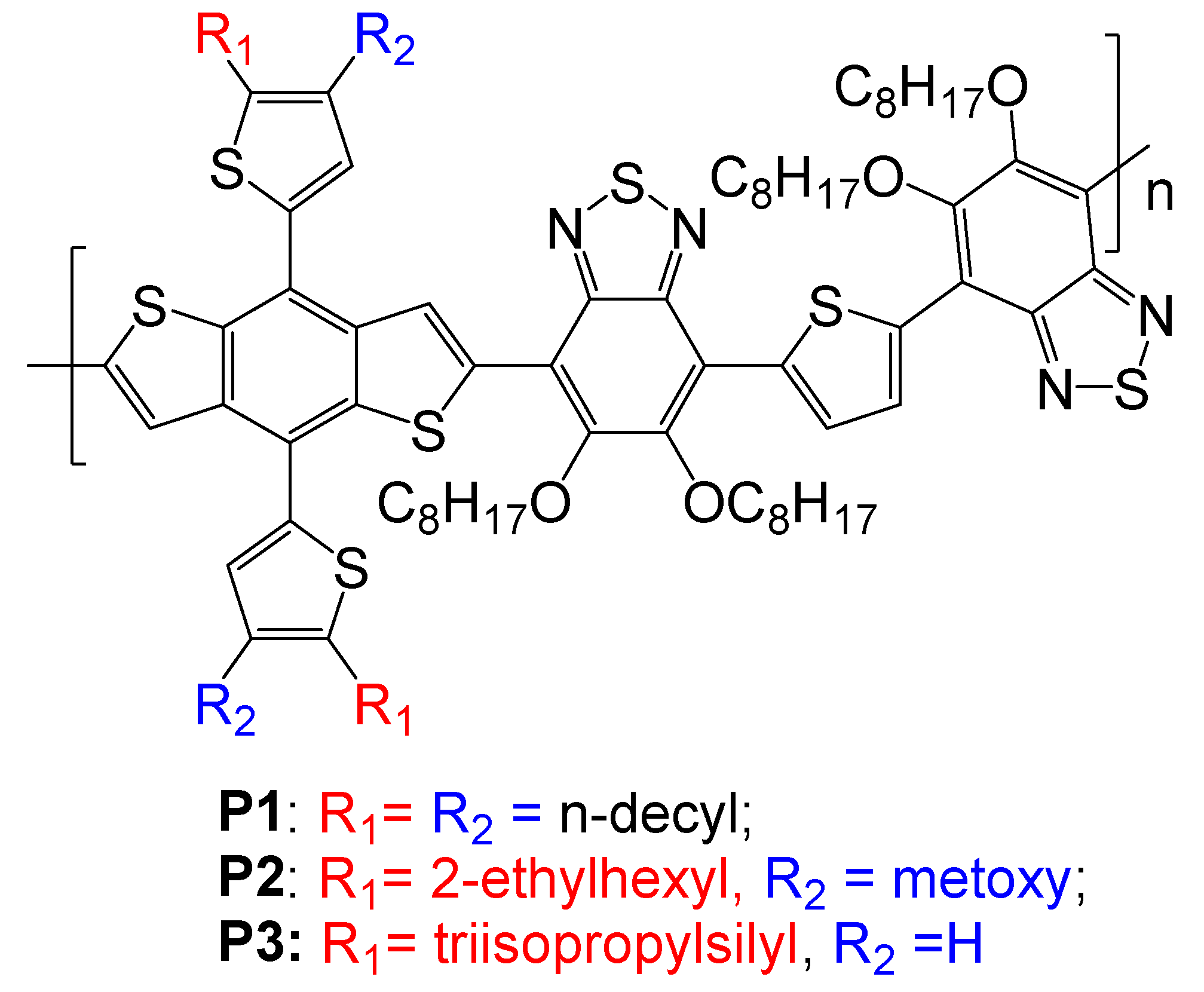
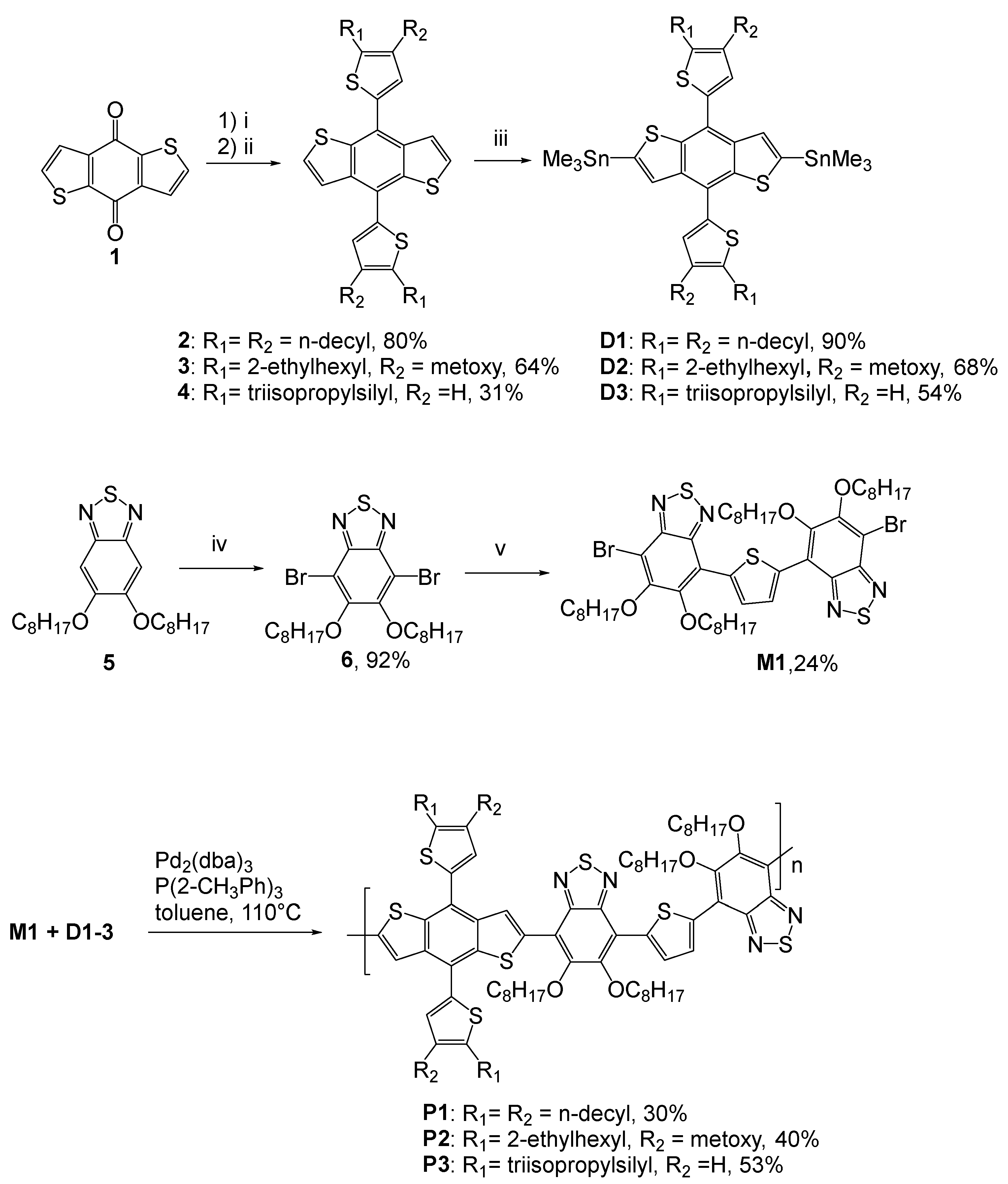
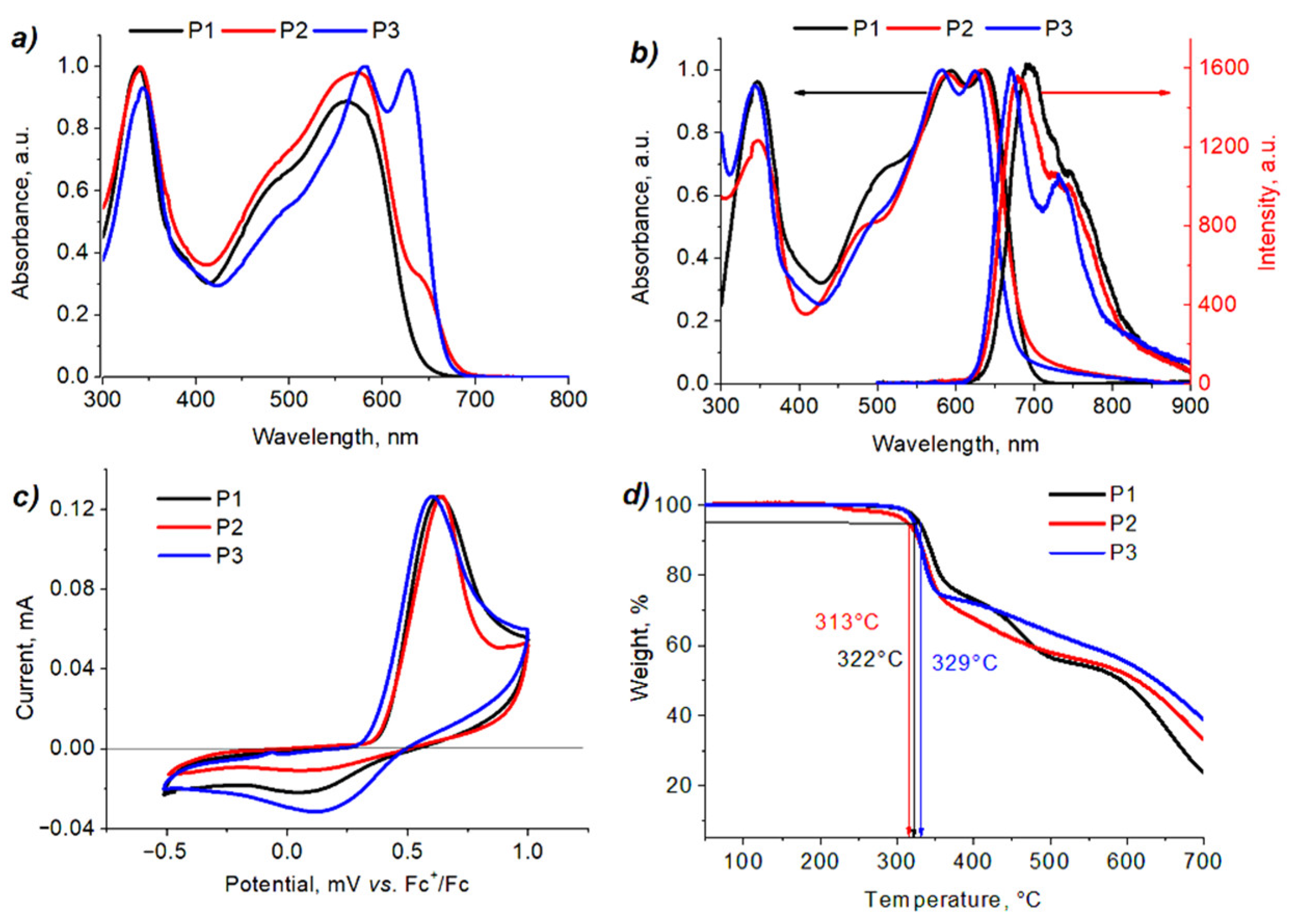
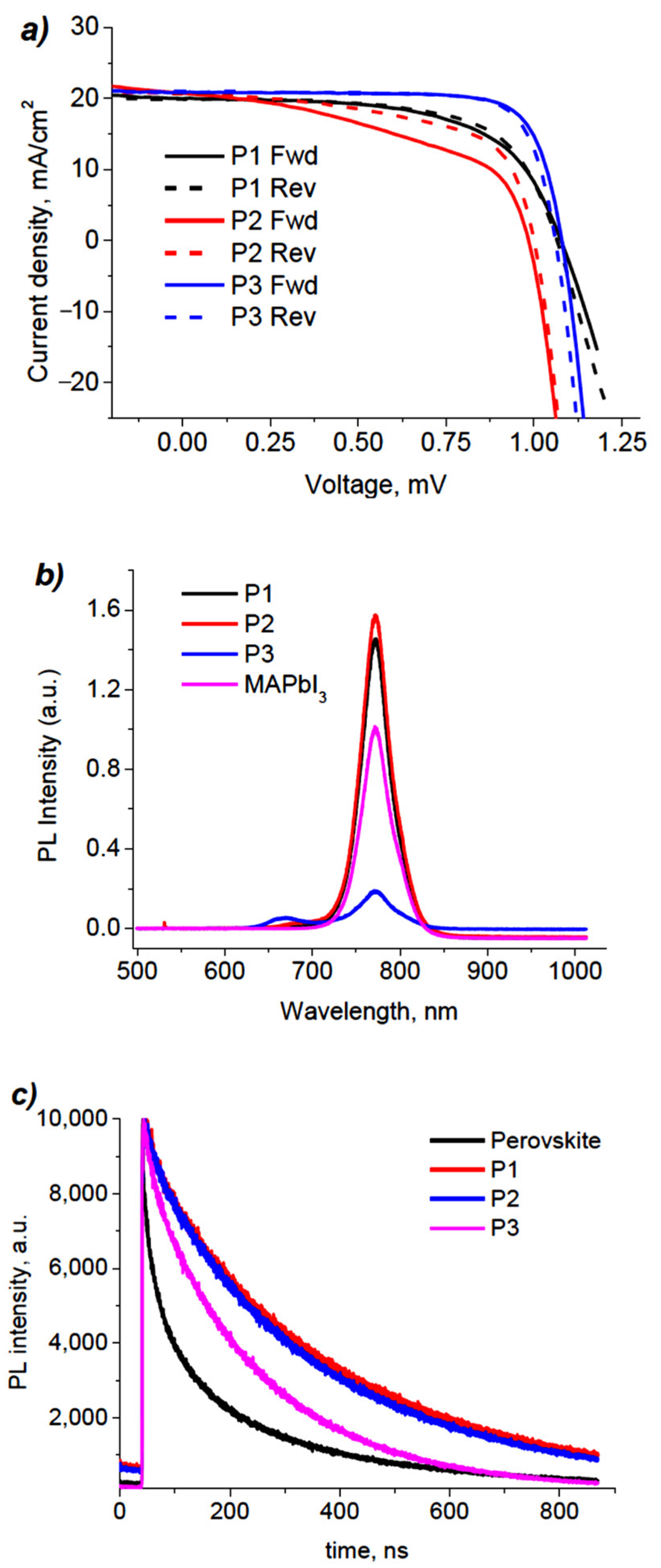
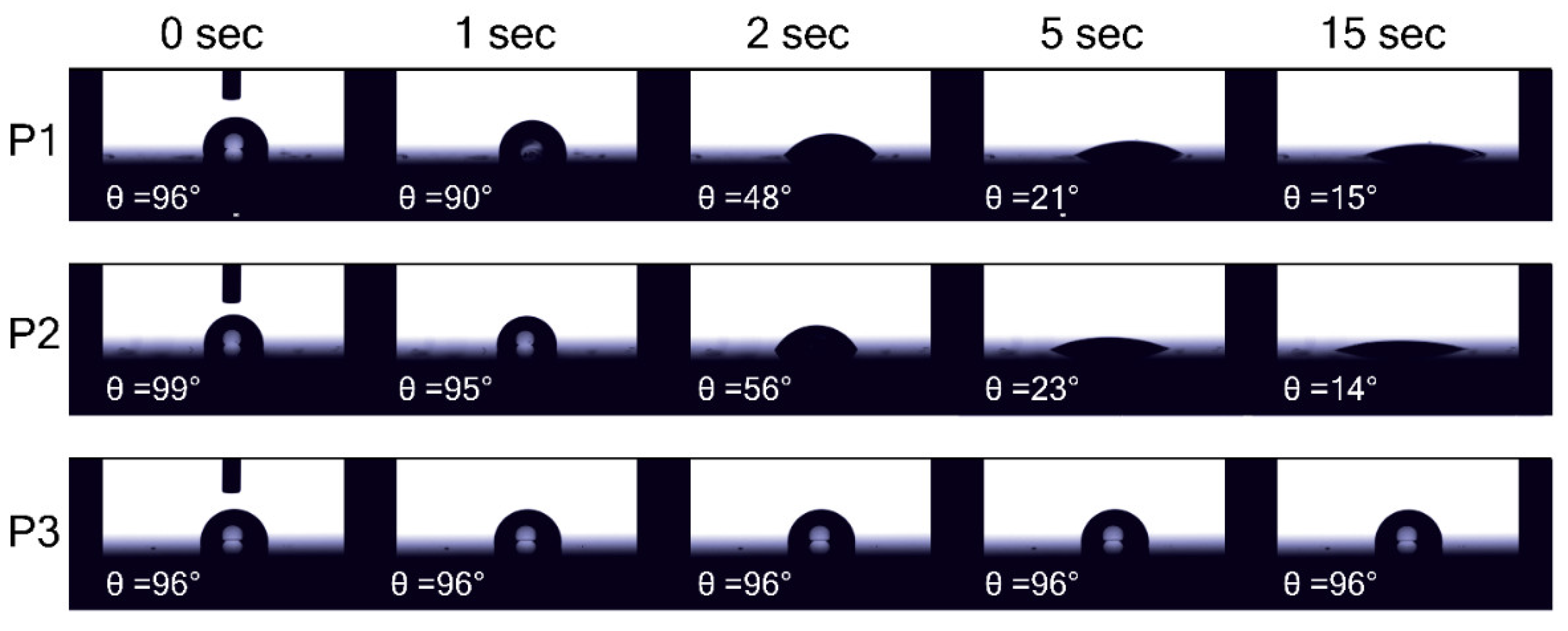
| Mw, kDa (Mw/Mn) | HOMO, eV | LUMO*, eV | Td, °C | |||||
|---|---|---|---|---|---|---|---|---|
| P1 | 13.3 (2.3) | 562/594,638/689 | 693 | 1.84 | 0.40 | −5.20 | −3.36 | 322 |
| P2 | 14.7 (2.3) | 572/587,632/683 | 678 | 1.85 | 0.39 | −5.19 | −3.34 | 313 |
| P3 | 21.6 (1.8) | 580,627/ 582,626/673 | 670 | 1.86 | 0.36 | −5.16 | −3.30 | 329 |
| HTM | μh, cm2V−1s−1 | VOC, mV | JSC, mA cm−2 | FF, % | PCE, % |
|---|---|---|---|---|---|
| PTAA | n/a | 1020 * (1040 ± 14) ** | 20.9 (21.0 ± 0.9) | 74 (68 ± 3) | 15.7 (14.7 ± 0.6) |
| P1 | 3.63 × 10−5 | 1060 (1000 ± 51) | 19.9 (21.1 ± 0.9) | 65 (57 ± 4) | 13.7 (12.2 ± 1.1) |
| P2 | 2.89 × 10−5 | 1000 (980 ± 12) | 20.7 (18.7 ± 1.3) | 60 (52 ± 6) | 12.4 (9.7 ± 1.5) |
| P3 | 4.10 × 10−5 | 1080 (1060 ± 11) | 20.9 (20.9 ± 0.5) | 77 (74 ± 1) | 17.4 (17.1 ± 0.6) |
Publisher’s Note: MDPI stays neutral with regard to jurisdictional claims in published maps and institutional affiliations. |
© 2022 by the authors. Licensee MDPI, Basel, Switzerland. This article is an open access article distributed under the terms and conditions of the Creative Commons Attribution (CC BY) license (https://creativecommons.org/licenses/by/4.0/).
Share and Cite
Mikheeva, A.N.; Kuznetsov, I.E.; Tepliakova, M.M.; Elakshar, A.; Gapanovich, M.V.; Gladush, Y.G.; Perepelitsina, E.O.; Sideltsev, M.E.; Akhkiamova, A.F.; Piryazev, A.A.; et al. Novel Push-Pull Benzodithiophene-Containing Polymers as Hole-Transport Materials for Efficient Perovskite Solar Cells. Molecules 2022, 27, 8333. https://doi.org/10.3390/molecules27238333
Mikheeva AN, Kuznetsov IE, Tepliakova MM, Elakshar A, Gapanovich MV, Gladush YG, Perepelitsina EO, Sideltsev ME, Akhkiamova AF, Piryazev AA, et al. Novel Push-Pull Benzodithiophene-Containing Polymers as Hole-Transport Materials for Efficient Perovskite Solar Cells. Molecules. 2022; 27(23):8333. https://doi.org/10.3390/molecules27238333
Chicago/Turabian StyleMikheeva, Aleksandra N., Ilya E. Kuznetsov, Marina M. Tepliakova, Aly Elakshar, Mikhail V. Gapanovich, Yuri G. Gladush, Evgenia O. Perepelitsina, Maxim E. Sideltsev, Azaliia F. Akhkiamova, Alexey A. Piryazev, and et al. 2022. "Novel Push-Pull Benzodithiophene-Containing Polymers as Hole-Transport Materials for Efficient Perovskite Solar Cells" Molecules 27, no. 23: 8333. https://doi.org/10.3390/molecules27238333
APA StyleMikheeva, A. N., Kuznetsov, I. E., Tepliakova, M. M., Elakshar, A., Gapanovich, M. V., Gladush, Y. G., Perepelitsina, E. O., Sideltsev, M. E., Akhkiamova, A. F., Piryazev, A. A., Nasibulin, A. G., & Akkuratov, A. V. (2022). Novel Push-Pull Benzodithiophene-Containing Polymers as Hole-Transport Materials for Efficient Perovskite Solar Cells. Molecules, 27(23), 8333. https://doi.org/10.3390/molecules27238333



.jpeg)



